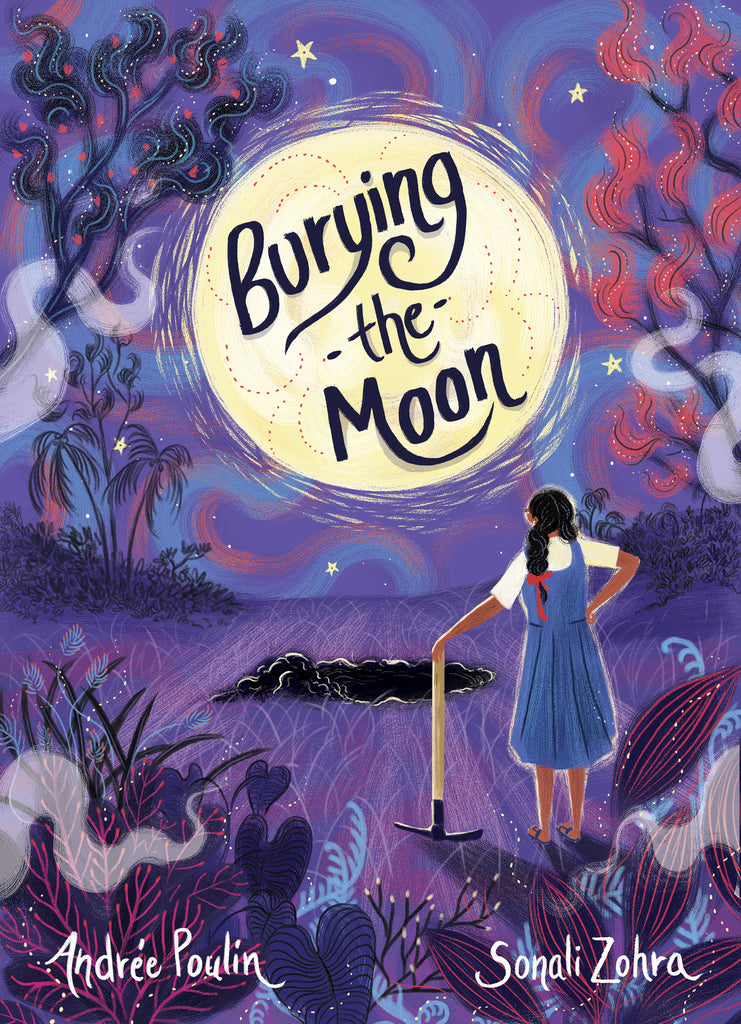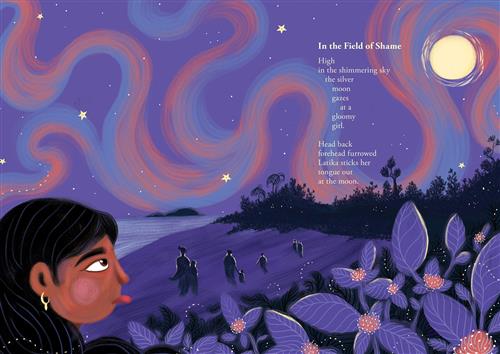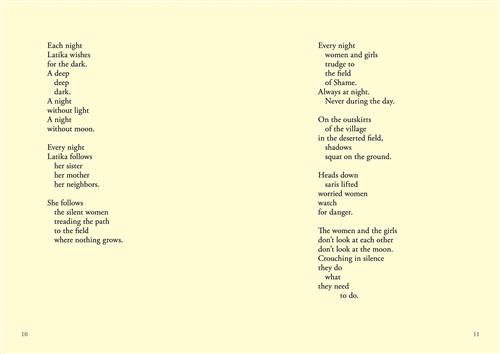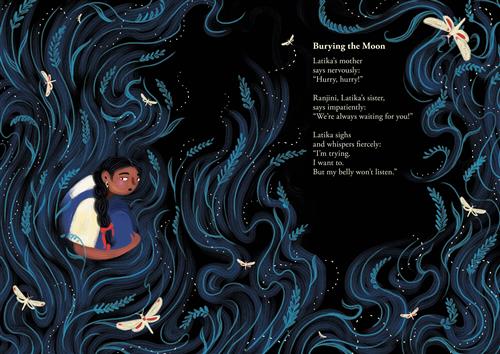A beautifully illustrated novel in verse about a young Indian girl who tackles the taboos around sanitation in her village.
In Latika’s village in rural India, there are no toilets. No toilets mean that the women have to wait until night to do their business in a field. There are scorpions and snakes in the field, and germs that make people sick. For the girls in the village, no toilets mean leaving school when they reach puberty.
No one in the village wants to talk about this shameful problem. But Latika has had enough. When a government representative visits their village, she sees her chance to make one of her dreams come true: the construction of public toilets, which would be safer for everybody in her village.
Burying the Moon shines a light on how a lack of access to sanitation facilities affects girls and women in many parts of the world.
Key Text Features
author's note
illustrations
Correlates to the Common Core State Standards in English Language Arts:
CCSS.ELA-LITERACY.RL.4.3
Describe in depth a character, setting, or event in a story or drama, drawing on specific details in the text (e.g., a character's thoughts, words, or actions).
CCSS.ELA-LITERACY.RL.5.3
Compare and contrast two or more characters, settings, or events in a story or drama, drawing on specific details in the text (e.g., how characters interact).
CCSS.ELA-LITERACY.RL.5.4
Determine the meaning of words and phrases as they are used in a text, including figurative language such as metaphors and similes.
CCSS.ELA-LITERACY.RL.5.5
Explain how a series of chapters, scenes, or stanzas fits together to provide the overall structure of a particular story, drama, or poem.
CCSS.ELA-LITERACY.RL.5.7
Analyze how visual and multimedia elements contribute to the meaning, tone, or beauty of a text (e.g., graphic novel, multimedia presentation of fiction, folktale, myth, poem).
CCSS.ELA-LITERACY.RL.6.3
Describe how a particular story's or drama's plot unfolds in a series of episodes as well as how the characters respond or change as the plot moves toward a resolution.
CCSS.ELA-LITERACY.RL.6.4
Determine the meaning of words and phrases as they are used in a text, including figurative and connotative meanings; analyze the impact of a specific word choice on meaning and tone
CCSS.ELA-LITERACY.RL.6.6
Explain how an author develops the point of view of the narrator or speaker in a text.
A beautifully illustrated novel in verse about a young Indian girl who tackles the taboos around sanitation in her village.
In Latika’s village in rural India, there are no toilets. No toilets mean that the women have to wait until night to do their business in a field. There are scorpions and snakes in the field, and germs that make people sick. For the girls in the village, no toilets mean leaving school when they reach puberty.
No one in the village wants to talk about this shameful problem. But Latika has had enough. When a government representative visits their village, she sees her chance to make one of her dreams come true: the construction of public toilets, which would be safer for everybody in her village.
Burying the Moon shines a light on how a lack of access to sanitation facilities affects girls and women in many parts of the world.
Key Text Features
author's note
illustrations
Correlates to the Common Core State Standards in English Language Arts:
CCSS.ELA-LITERACY.RL.4.3
Describe in depth a character, setting, or event in a story or drama, drawing on specific details in the text (e.g., a character's thoughts, words, or actions).
CCSS.ELA-LITERACY.RL.5.3
Compare and contrast two or more characters, settings, or events in a story or drama, drawing on specific details in the text (e.g., how characters interact).
CCSS.ELA-LITERACY.RL.5.4
Determine the meaning of words and phrases as they are used in a text, including figurative language such as metaphors and similes.
CCSS.ELA-LITERACY.RL.5.5
Explain how a series of chapters, scenes, or stanzas fits together to provide the overall structure of a particular story, drama, or poem.
CCSS.ELA-LITERACY.RL.5.7
Analyze how visual and multimedia elements contribute to the meaning, tone, or beauty of a text (e.g., graphic novel, multimedia presentation of fiction, folktale, myth, poem).
CCSS.ELA-LITERACY.RL.6.3
Describe how a particular story's or drama's plot unfolds in a series of episodes as well as how the characters respond or change as the plot moves toward a resolution.
CCSS.ELA-LITERACY.RL.6.4
Determine the meaning of words and phrases as they are used in a text, including figurative and connotative meanings; analyze the impact of a specific word choice on meaning and tone
CCSS.ELA-LITERACY.RL.6.6
Explain how an author develops the point of view of the narrator or speaker in a text.
| Published By | Groundwood Books Ltd — Oct 1, 2021 |
| Specifications | 112 pages | 6 in x 8.5 in |
| Keywords | CC Literature Craft and Structure; CC Literature Integration of Knowledge and Ideas; grade 4; grade 5; grade 6; illustrated novel in verse; middle grade fiction; author's note; illustrations; award winning author; award-winning author; beautiful illustrations; |
| Written By |
ANDRÉE POULIN was born in Orléans, Ontario and today lives in Gatineau, Quebec. She has published more than fifty books and has been a finalist several times for the Governor General’s Award and the TD literary award, winning the latter in 2014 for La plus grosse poutine du monde. She worked in international development assistance for more than a decade before becoming an author. |
| Illustrated by |
SONALI ZOHRA is a Indian illustrator living in Bangalore. She studied fine arts and photography, and holds a master’s degree in design from the University of South Wales, in Australia. She is fully aware of the lack of sanitation facilities as depicted in this novel. When she was small, she would often accompany her father, who worked for UNICEF India on projects concerning women’s health in rural areas. |
| Written By |
|
ANDRÉE POULIN was born in Orléans, Ontario and today lives in Gatineau, Quebec. She has published more than fifty books and has been a finalist several times for the Governor General’s Award and the TD literary award, winning the latter in 2014 for La plus grosse poutine du monde. She worked in international development assistance for more than a decade before becoming an author. |
| Illustrated by |
|
SONALI ZOHRA is a Indian illustrator living in Bangalore. She studied fine arts and photography, and holds a master’s degree in design from the University of South Wales, in Australia. She is fully aware of the lack of sanitation facilities as depicted in this novel. When she was small, she would often accompany her father, who worked for UNICEF India on projects concerning women’s health in rural areas. |
| Audience | ages 9 to 12 / grades 4 to 7 |
| Reading Levels |
Guided Reading W
Fountas & Pinnel Text Level W |
| Key Text Features | author's note; illustrations |
| Common Core |
CCSS.ELA-LITERACY.RL.5.5
CCSS.ELA-LITERACY.RL.6.3 CCSS.ELA-LITERACY.RL.4.3 CCSS.ELA-LITERACY.RL.6.4 CCSS.ELA-LITERACY.RL.6.6 CCSS.ELA-LITERACY.RL.5.4 CCSS.ELA-LITERACY.RL.5.3 CCSS.ELA-LITERACY.RL.5.7 |
Winner, South Asia Book Award, 2022
Commended, Bank Street College of Education Best Children's Books of the Year, 2022
Short-listed, Saskatchewan Young Readers’ Choice Awards, Diamond Willow Award, 2022
Nominated, Rocky Mountain Book Award, 2023
Commended, Canadian Children’s Book Centre, Best Books for Kids and Teens, 2022
[E]nriches broader discussions of world issues. STARRED REVIEW
” —BooklistA book that will both captivate and raise consciousness in readers of all ages.
” —Montreal Review of Books[An] intense and moving novel.
” —CM: Canadian Review of MaterialsAndrée Poulin's verse and Sonali Zohra's colourful illustrations are paired perfectly in this book that brings awareness to a very important issue.
” —Canadian Children's Book NewsAn essential read and a great way to discuss often-ignored questions of sanitation, menstruation, and equity with young readers.
” —Open BookInspiring. The text is heavy with meaning and emotion but short on filler.
” —CanLit for LittleCanadians BlogA well-balanced mix of poignant, humorous, interesting, and profound.
” —Cloud Lake LiteraryThe illustrations by Indian artist Sonali Zohra fit seamlessly with the text.
” —Winnipeg Free PressThis title will inspire matter-of-fact classroom conversations about a basic utility service that is likely taken for granted in most of North America.
” —School Library ConnectionPowerful.
” —Horn BookThis simple story brings to light the plight that more than half of the world’s population faces when there are no toilets. An important book to be read and discussed with older readers.
” —Calgary HeraldBurying the Moon is a story that will make young girls stand up and cheer for Latika, its heroine. She is one of the world's 600 million people who do not have access to toilets, and she decides to do something about it. The story is beautifully, poetically told and the book is illustrated with the breathtaking artwork of Sonali Zohra. Readers will come away thinking, "Here's a problem that can be solved. Let's help solve it." Wonderfully done!
” —Deborah Ellis, bestselling author of The Breadwinner series



